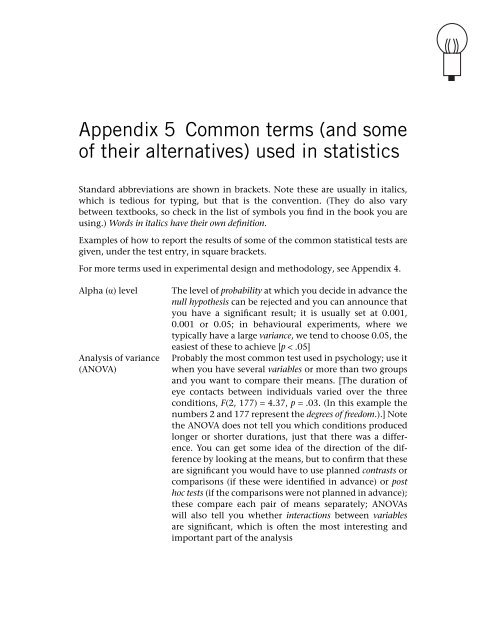Psychology - Forgot your username
Psychology - Forgot your username
Psychology - Forgot your username
You also want an ePaper? Increase the reach of your titles
YUMPU automatically turns print PDFs into web optimized ePapers that Google loves.
Appendix 5 Common terms (and some<br />
of their alternatives) used in statistics<br />
Standard abbreviations are shown in brackets. Note these are usually in italics,<br />
which is tedious for typing, but that is the convention. (They do also vary<br />
between textbooks, so check in the list of symbols you find in the book you are<br />
using.) Words in italics have their own definition.<br />
Examples of how to report the results of some of the common statistical tests are<br />
given, under the test entry, in square brackets.<br />
For more terms used in experimental design and methodology, see Appendix 4.<br />
Alpha (α) level The level of probability at which you decide in advance the<br />
null hypothesis can be rejected and you can announce that<br />
you have a significant result; it is usually set at 0.001,<br />
0.001 or 0.05; in behavioural experiments, where we<br />
typically have a large variance, we tend to choose 0.05, the<br />
easiest of these to achieve [p < .05]<br />
Analysis of variance Probably the most common test used in psychology; use it<br />
(ANOVA) when you have several variables or more than two groups<br />
and you want to compare their means. [The duration of<br />
eye contacts between individuals varied over the three<br />
conditions, F(2, 177) = 4.37, p = .03. (In this example the<br />
numbers 2 and 177 represent the degrees of freedom.).] Note<br />
the ANOVA does not tell you which conditions produced<br />
longer or shorter durations, just that there was a difference.<br />
You can get some idea of the direction of the difference<br />
by looking at the means, but to confirm that these<br />
are significant you would have to use planned contrasts or<br />
comparisons (if these were identified in advance) or post<br />
hoc tests (if the comparisons were not planned in advance);<br />
these compare each pair of means separately; ANOVAs<br />
will also tell you whether interactions between variables<br />
are significant, which is often the most interesting and<br />
important part of the analysis






